If you are still considering where to go this year our recent travel writer documented some amazing routes for a road trip through Andalusia. The well-known travel blogger Oliver Bock went through Spain photographing his journey exclusively for Sixt. Follow him through his 16 stops across Andalusia – the ‘land of rabbits’. You can see his routes and adventures below with some great tips if you decide to go yourself.
Driving long distance through a country is a great way to meet a variety of people, while also letting you set your own pace. Andalusia is in southern Spain and is larger than Switzerland. It is the intersection between Africa and Europe, the Mediterranean and the Atlantic. The landscapes are incomparable holding the highest mountain of the Iberian Peninsula, the Sierra Nevada, the Strait of Gibraltar, volcanic regions like the Tavernas Desert, and unique sandy. Oliver’s journey took him from Madrid via Toledo and Seville to the southern point of Cadiz and from there via Malaga, Granada, Alicante up to Valencia. For approximately 1600 kilometres. Oliver was driving the new Mercedes A-Class, a sporty A200d.
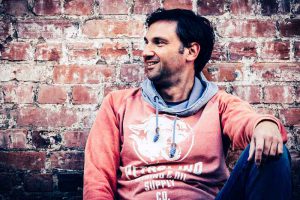
Oliver Bock is a Travel Photographer and Social Media Influencer. He started the local Instagram community @IgersHamburg and organises InstaWalks and Meets for his community in Hamburg. He was born in 1973 and is living in Hamburg. His biggest passions are traveling and photography. With the rise of Instagram in recent years, he started getting into travel photography more and more.
The Starting Point
It all started in Madrid, the capital of Spain. The city has an abundance of sights and activity. It’s both perfect for a long stay, and perfect for a short sightseeing trip. It is an urban masterpiece filled with collections of European art and impressive architecture. The city is unbelievable, both in terms of its beauty and the number of visitors it attracts. It’s relaxed and bohemian vibe is comparable to Berlin and other major European cities with a top night life. The Mercedes Oliver drove was fully air-conditioned, which is particularly needed during hotter months, but on cooler days it’s better to let the window down and let in the sounds of the city.

Here are the Top 10 sights before continuing towards Cordoba:
- Plaza de España
- Santiago-Bernabéu-Stadion
- Museo Nacional Centro de Arte Reina Sofía
- Museo del Prado
- Palacio Real
- Plaza Mayor
- Gran Vía
- Thyssen-Bornemisza Museum
- Círculo de Bellas Artes
- Parque del Buen Retiro
The Road Trip Starts
Oliver’s route took him first onto the A 42 via Toledo to Cordoba where he took the first photo of his trip (below). Those white houses you see are all over Cordoba. The composition includes the area’s colourful windows and doors, as well as the clear Spanish sky above, creating an ideal picture. Cordoba is known mainly for its Mosque-Cathedral (or also Mezquita-Catedral) dating back to the era of Moorish Spain. It covers approx. 23,000 m² making it one of the world’s largest. It is also a UNESCO world cultural heritage sight. The Puente Romano (Roman bridge) built of 16 arches is also an important structure, a truly majestic sight comparable to the Charles Bridge in Prague. In addition to these two points of interest you should also make sure to check out all the small alleys around old town. The place is filled with beautiful white houses lined with colourful walls. With the A-Class he could cover much of the city in comfort and style but particularly enjoyed parking it to explore the narrow alleys of Cordoba.
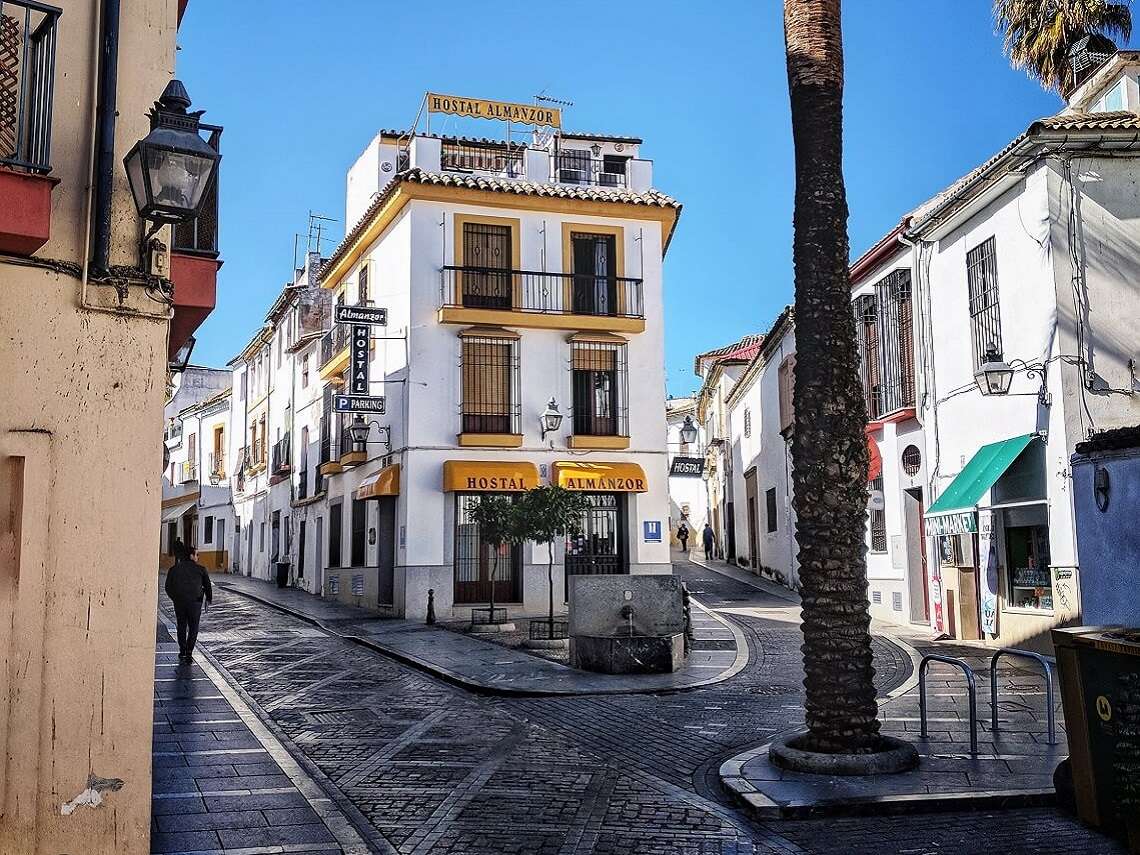
Here are the top 10 sights before continuing towards Seville:
- Palacio de la Merced
- Alcazar de los Reyes Cristianos
- Patios de Cordoba
- Calleja de las Flores
- Santa Marina de Aguas Santas Church
- Cristo de los Faroles
- Los Patios del Alcazar Viejo
- Cairuan Street
- Patio de los Naranjos
- Puerta del Almodovar
After Cordoba there was a detour in the direction of Sevilla all the way into the Sierra Norte, a perfect place for hiking and cycling. At 177,000 hectares the nature park in the west of the Sierra Morena is only 45 km away from the Andalusian capital, Sevilla. Crossing the dam on the SE-179 near Pantano El Pintad turned out to be the perfect setting for a photo. The Sierra Norte Nature Reserve is filled with rivers sourced from the ancient mountain massifs. Hikers will find a series of trails both through forests as well as huge spread of Mediterranean vegetation. It is the only place on earth with limestone karst formations that have given the Sierra Norte an admission into the network of European Geoparks.
Those who love the outdoors could hike here for days, and many do. Much of the park’s most beautiful areas are better accessible with a rental car. We recommend switching off the radio during these sections and instead listening to the sound of nature. Driving in the park on routes like the A-450 is picturesque though the smaller roads are not perfect for driving, but this was no problem for Oliver’s rental.

After the trip, the next stop on Oliver’s journey was Seville, the capital of the southern Spanish region of Andalusia – known famously as the cradle of flamenco. Oliver took this photo on the Metropol Parasol at sunset in Seville. Be warned, long queues at sunrise and sunset are guaranteed. But it’s worth it for a truly beautiful view of Sevilla. The Metropol Parasol is a breathtaking wooden construction within old town. It’s 150 metres in length with a width of 70 metres and a height of 26 metres. The construction consists of six umbrella-shaped structures. Parking nearby was no problem and for 3€ you can walk around the building.
Here are the top 10 sights before continuing towards Cadiz:
- Santa María de la Sede
- Basilica de Jesús del Gran Poder
- Iglesia de la Magdalena
- Iglesia de San Antonio Abad
- Museum of Fine Arts
- Las Duenas
- Plaza de Toros de la Maestranza
- Plaza del Triunfo
- Plaza de las Cruces
- Torre del Oro
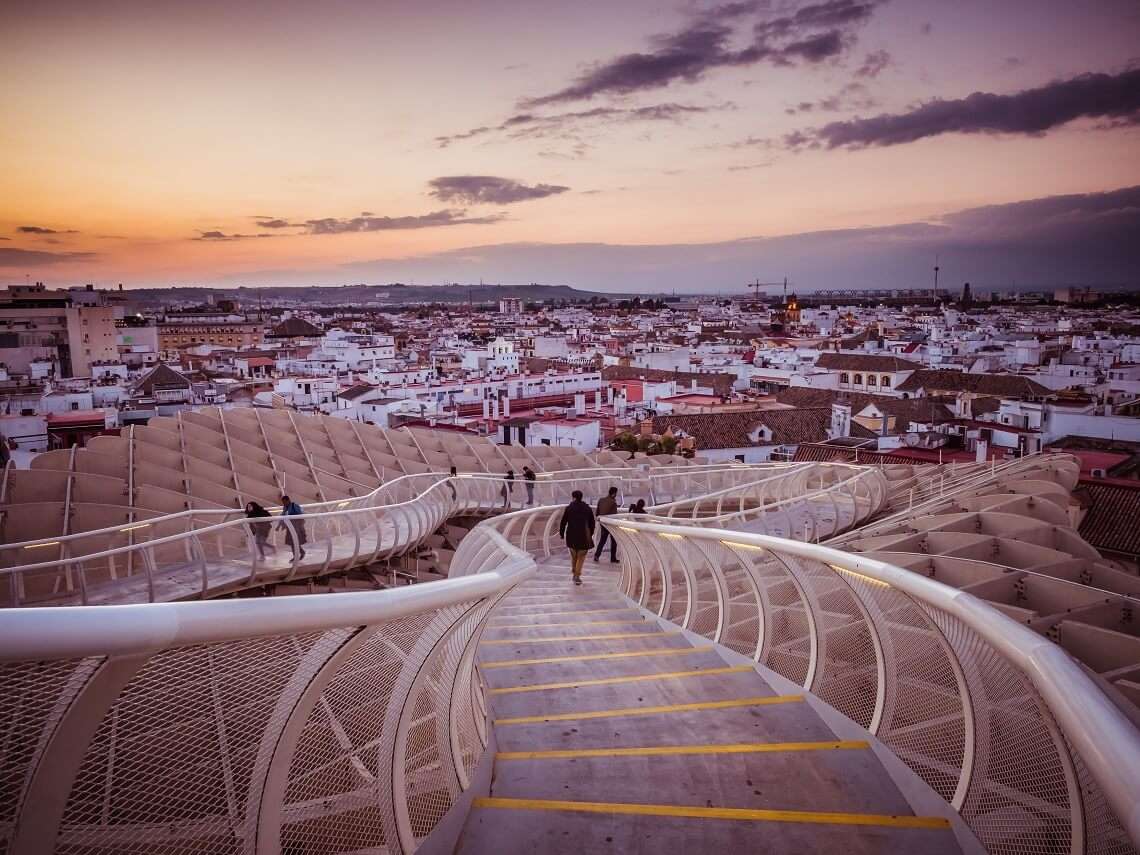
In Sevilla there was time for a spectacular photo of the car in a halfpipe. Perfect morning light provided this awesome shot in the suburbs of Seville. The spot is located in the former world exhibition grounds near the Olympic Stadium.
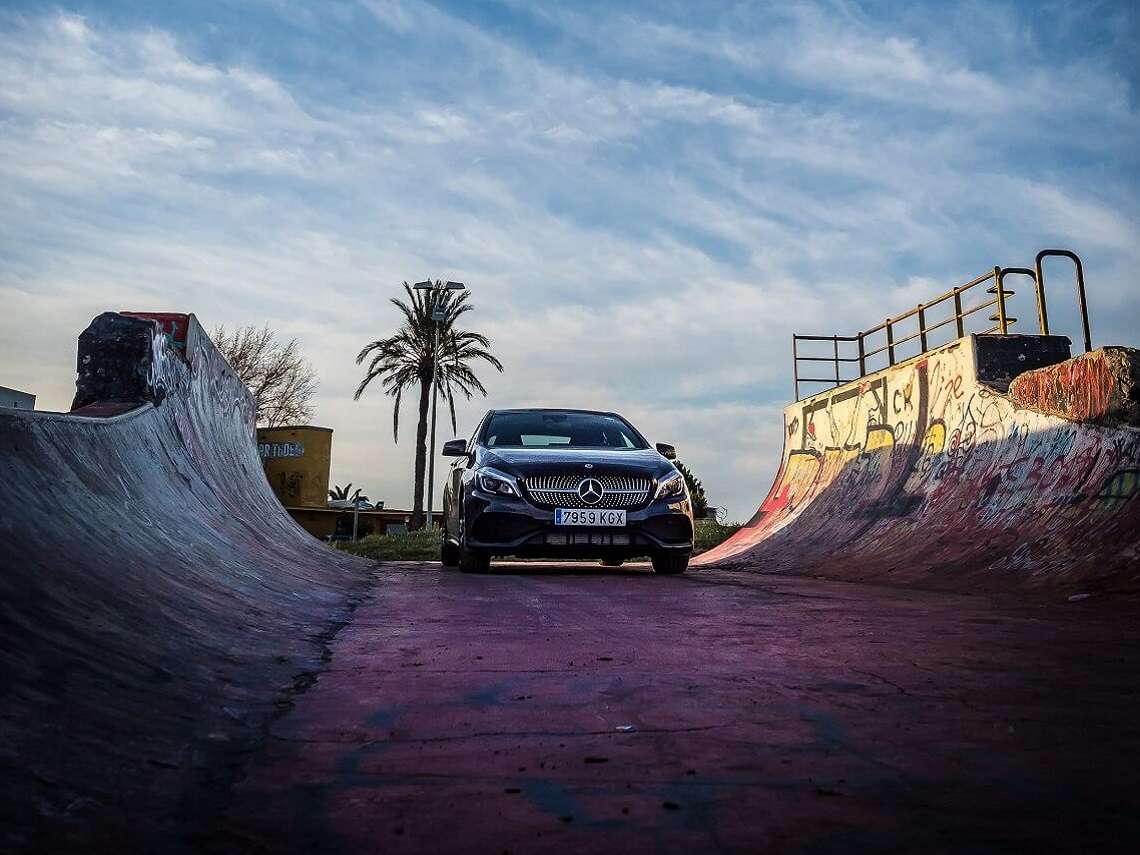
After Sevilla he went by the Atlantic coast to Cadiz. The route led almost directly south and Oliver needed around an hour and a half on the P-4 to get there. On the beach of Cadiz you can watch a wonderful sunrise, as his photo below shows. Our rental car had to step in as the model for Oliver’s photo. The photo was taken early morning while the town was still sleeping. Cádiz is one of the oldest cities in Western Europe, it lies on a headland and has about 11,0000 inhabitants. You can see Cadiz is a port city through and through with more than a hundred watchtowers serving as a lookout for ships. Everything in Cadiz is just a bit more authentic, raw and original. The best way to experience the quaintness of the city is to walk through the Torreon de las Puertas de Tierra, which separates the New Town from the Old Town. Pure magic.

A Change in Architecture and Scenery
Here are the Top 10 sights before continuing towards Grazalema:
- Yacimiento Arqueologico Gadir
- Park Genoves
- Teatro Romano
- Torre Tavira
- Gran Teatro Falla
- Puerta de Tierra
- Castillo de San Sebastian
- Casa-Palacio Moreno de Mora
- Hospital de Mujeres
- Oratorio de La Santa Cueva
From Cadiz Oliver’s tour took him to Grazalema, which belongs to the Pueblos Blancos (white villages) of Andalusia. These villages are iconic because of their whitewashed houses and the narrow, winding alleys, a style of housing found in North Africa. There is even a route called Ruta de los Pueblos Blancos, which leads through a series of these small towns and villages across a mountainous landscape. Grazalema is located in the north-east of the province of Cadiz (Andalusia/Spain) at the foot of the Sierra del Pinar mountains. Our rental car proved to have great handling even on wet roads. Oliver had some moody weather while driving through the winding roads through Grazalema creating a different picture in comparison to the empty blue skies behind him. The photo spot is located just above Grazalema at the campsite.

Spontaneous stops are a part of any great Road Trip. Finding that quiet spot somewhere along the road, a place you otherwise may have sped by without a second thought, can be some of the most serenely special parts of a long drive. Somewhere between Malaga and Granada this photo below was taken, an incredible and mountainous view with blue sky above. Oliver stopped here briefly by for a view of the surrounding villages. He left the rental car to cool under the shade of a big tree.
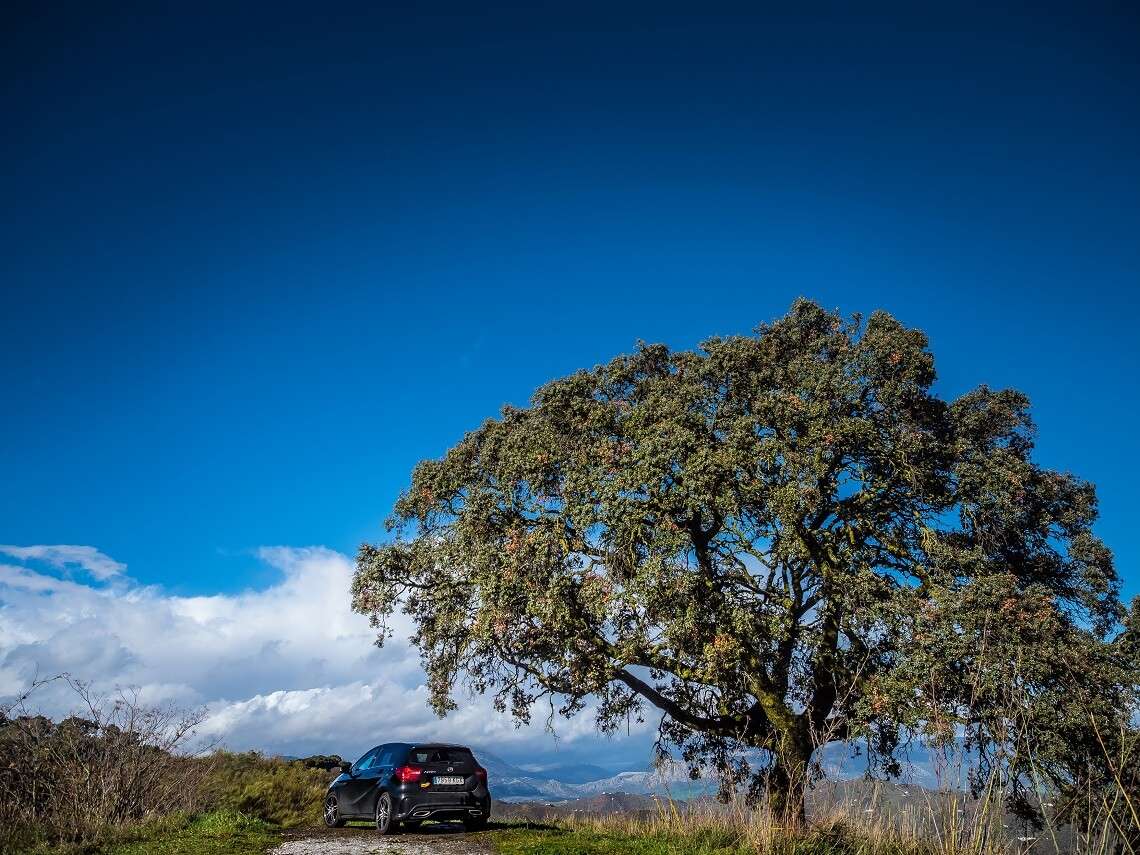
Arriving at Granada marked the journey’s last leg. More than half of the route was now covered. The view of the city and its white houses from the Alhambra in Granada was a highlight of the journey. A beautiful sight even under grey sky. The Alhambra is a must see in Granada, however it is very touristic so be prepared for crowds. To visit the Nasrid Palaces (a must) it is important to book a ticket for a certain time slot in advance, spontaneously visiting is not wise.

Here are the top 10 sights before continuing on to Valencia:
- Alhambra
- Generalife
- Palast Karl V
- Hammam Al Andalus Granada
- Carrera del Darro
- Paseo de los Tristes
- Puerta de Elvira
- Iglesia del Sagrario
- Carmen de los Martires
- Plaza de San Nicolas
Oliver’s journey took him from Granada on the E-15 towards Murcia. Shortly before that he made a detour to Barrancos de Gebas. The Barrancos are located somewhere in the empty west of Murcia, and is not your typical destination. A fabulous view of turquoise water amidst breathtaking rock formations awaits any visitor. The Barrancos are a nature reserve ideal for hiking offering unique views. Since it is a bit off the beaten track the best way to reach it is by rental car. The road is not the best, but the Mercedes A-Class mastered the tour effortlessly.
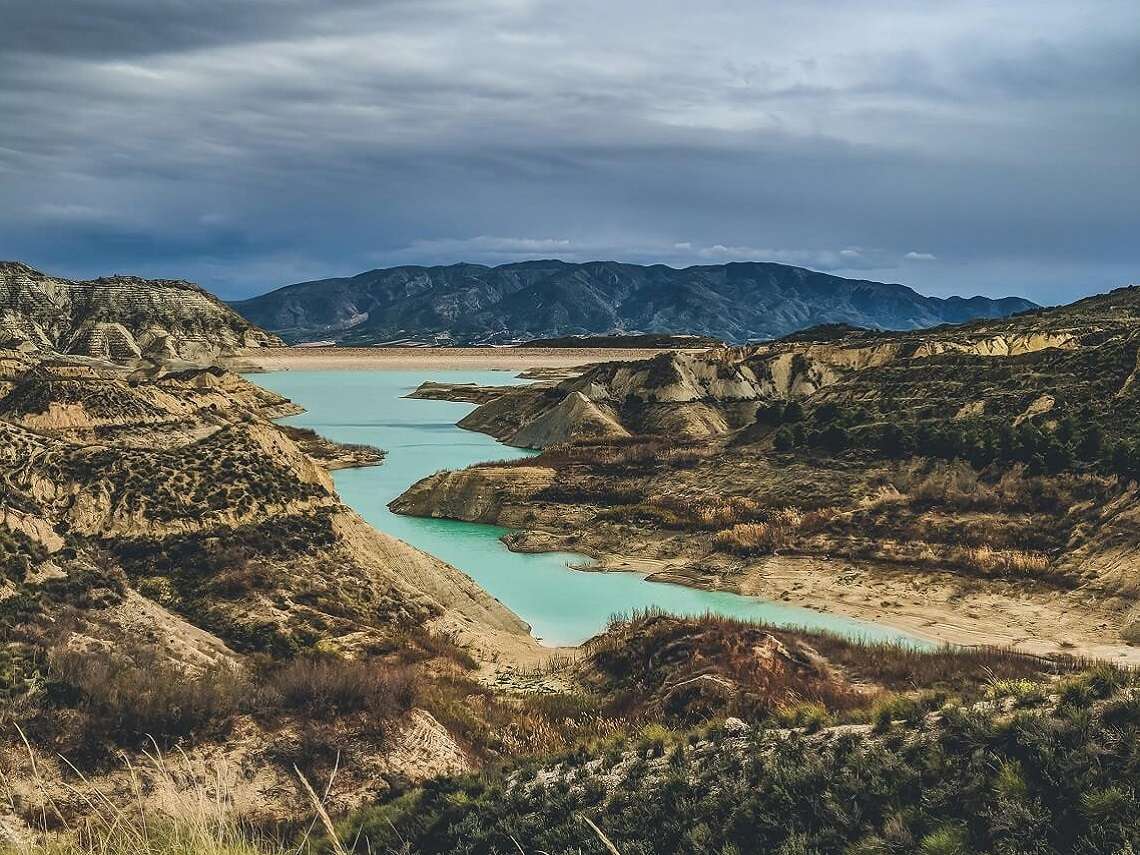
The End Game
Now there were only two stops left on the journey: Alicante and Valencia. Alicante is a port city located at the foot of the castle Santa Bárbara lying in the middle of the Costa Blanca. Directly on the Mediterranean Sea, the climate covers this spot of land with sunshine almost all year round. It is sublime to stand in the warm sea and watch the mountains rise directly behind the beach. It’s not just the sky that’s captivating: The Explanada de España Promenade consists of 6.5 million mosaic tiles. From here he went directly to Valencia, the crowning conclusion of the 1600 kilometre tour, just two hours away. Arabic countries brought the rice trade to Valencia and laid the foundation stone for the worldwide symbol of Spanish cuisine: the paella. Valencia can be exquisite as Barcelona and is even cheaper. The city is also the greenest in the country. On top of all that 2,000 years of history and artifact lie with the Santa Maria Cathedral. Don’t miss the Turia Gardens, which span across the whole of Valencia.

Oliver’s road trip took him through almost all the important cities within that part of the country. It included some incredible landscapes that he would otherwise never have seen without a rental car. In March the climate was still mild and the traffic flowed well. The mix of city and nature reserves ensured that there was never a dull moment and that there was no shortage of places to drive to.
For the hikes we recommend:
- Comfortable hiking boots
- Sturdy backpack
- First Aid
- Rain poncho
- Light Cap
- Proper hiking shorts
- Reusable water bottle